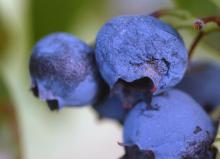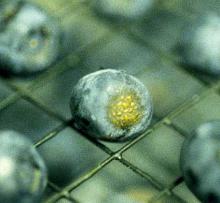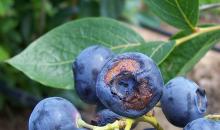See:
Blueberry Cultivar Susceptibility
Cause The fungus Colletotrichum fioriniae (formerly Colletotrichum acutatum). This disease can appear on fruit before harvest (ripe rot) but more often appears as a postharvest fruit rot. Warm, wet, humid conditions favor disease spread and buildup. Spores are dispersed by splashing rain or irrigation. Infection can occur any time during bloom and berry development. One study found that 10 hours of continual leaf wetness at 52°F to 60°F is necessary for infection, while another study found it needed 18 to 24 hours of wetness at those temperatures. Dry interruptions during this time can inhibit successful infection. Floral extracts from susceptible cultivars increased appressorial formation and infection of fruit in the lab. Berry infections remain quiescent (latent) until fruit is nearly mature. The fungus overwinters in blighted twigs, fruit trusses and floral bud scales. Floral bud scales that persist on fruit clusters are considered an important source of the fungus. Removal and destruction of prunings from the field did not reduce primary inoculum and had little impact on disease development.
The cultivars such as Bluecrop, Blueray, Bluetta, Earliblue, Herbert, and Spartan are very susceptible while the cultivars Collins, Elliot, and Weymouth are considered resistant.
Symptoms Blighting of shoot tips may be observed first. Then, a few flowers turn brown or black. Leaf spots, when they occur, are large or small and roughly circular. As infected berries ripen, the flower end may soften and pucker. Under warm and rainy conditions, salmon-colored spore masses form on infected berries. However, there may also be no indication of disease prior to harvest. After harvest, spore masses form rapidly on infected fruit when in cellophane-covered baskets or in plastic clamshell packs.
Cultural control A combination of cultural and chemical practices is most helpful in combating losses due to this disease.
- Avoid overhead irrigation or apply such that plants are not wet for extended periods of time.
- Lower the temperature of harvested fruit as soon as possible after picking.
- Prune bushes for adequate airflow and to reduce drying time after becoming wet.
Chemical control Apply during bloom and use along with cultural practices. Applications may be needed after bloom in especially wet years. Exclusive use of some products, such as Indar (FRAC 3 fungicide), for mummy berry management has resulted in elevated levels of ripe rot. Although this may be an artifact of fungicide testing trials, addition of broad-spectrum fungicides in an overall program is recommended.
- Abound at 6 to 15.5 fl oz/A. Do not apply with silicone-based surfactants. May be applied on the day of harvest. Group 11 fungicide. 4-hr reentry.
- Captan 80 WDG at 1.25 to 3 lb/A plus spreader-sticker. May be applied up to day of harvest. Moderately effective. Group M4 fungicide. 48-hr reentry.
- CaptEvate 68 WDG at 3.5 to 4.7 lb/A. Can be used day of harvest. Group 17 + M4 fungicide. 48-hr reentry.
- Cevya at 4 to 5 fl oz/A. Can be used on day of harvest. Group 3 fungicide. 12-hr reentry.
- EcoSwing at 1.5 to 2 pt/A. Can be used day of harvest. Group BM01 fungicide. 4-hr reentry. O
- Inspire Super at 16 to 20 fl oz/A. Do not apply within 7 days of harvest. Group 3 + 9 fungicide. 12-hr reentry.
- Miravis Prime at 13.4 fl oz/A. May be used day of harvest. Group 7 + 12 fungicide. 12-hr reentry.
- Omega 500 F at 20 fl oz/A. Do not use with an adjuvant or within 30 days of harvest. Group 29 fungicide. 12-hr reentry.
- Pristine at 18.5 to 23 oz/A. Do not use with any other tank additive except Captan. Can be used day of harvest. Group 7 + 11 fungicide. 12-hr reentry.
- Propulse at 10 to 13.6 fl oz/A. Do not use within 7 days of harvest. Group 3 + 7 fungicide. 12-hr reentry.
- Quadris at 6 to 15.5 fl oz/A. Do not apply with silicone-based surfactants. May be applied on the day of harvest. Group 11 fungicide. 4-hr reentry.
- Quadris Top at 12 to 14 fl oz/A. Do not apply within 7 days of harvest. Group 3 + 11 fungicide. 12-hr reentry.
- Quash at 2.5 oz/A. Do not use within 7 days of harvest. Group 3 fungicide. 12-hr reentry.
- Regev at 4 to 8.5 fl oz/A. Do not apply within 2 days of harvest. Group 3 + BM01 fungicides. 12-hr reentry.
- Switch 62.5 WG at 11 to 14 oz/A. May be used up to and including the day of harvest. Group 9 + 12 fungicide. 12-hr reentry.
- Vacciplant at 14 to 22 fl oz/A. Can be used day of harvest. Unknown efficacy in the PNW. Group P4 fungicide. 4-hr reentry.
- Ziram 76 DF at 3 lb/A. Do not apply after 3 weeks from full bloom. Moderate to poor control ranking. Group M3 fungicide. 48-hr reentry.
Notes: Although Aliette (Group P7 fungicide) is registered for use, it was effective in only 3 of 9 trials.
Although chlorothalonil products (Bravo and Echo) are registered, their performance has been quite variable and more often ineffective than effective. Since it cannot be used after early bloom, it is not recommended for controlling this disease.
Although Indar is registered, it has not been very effective in western Oregon trials.
Regalia was not effective in two tests in western Oregon.
Some registered products offer only suppression of this disease and thus are not recommended for use. These products include Howler, Oso, and Serenade.
Biological control
- Serenade Garden Disease Control Concentrate at 2 to 4 fl oz/gal water. Reduced disease development in Michigan when mixed with a surfactant but unknown effectiveness in the PNW. H O
References Miles, T.D., Gillett, J.M., Jarosz, A.M., and Schilder, A.M.C. 2013. The effect of environmental factors on infection of blueberry fruit by Colletotrichum acutatum. Plant Pathology 62:1238-1247.
Waller, T.J., Vaiciunas, J., Constantelos, C., and Oudemans, P.V., 2018. Evidence that blueberry floral extracts influence secondary conidiation and appressorial formation of Colletotrichum fioriniae. Phytopathology 108:561-567.




